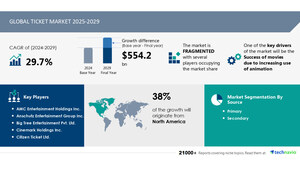NEW YORK, Sept. 4, 2024 /PRNewswire/ -- Report on how AI is redefining market landscape- The global monosodium glutamate (MSG) market size is estimated to grow by USD 1.64 billion from 2024-2028, according to Technavio. The market is estimated to grow at a CAGR of 5.52% during the forecast period. Increased awareness and acceptance of msg is driving market growth, with a trend towards expansion of msg applications. However, misinformation and negative consumer perception regarding MSG poses a challenge. Key market players include Ace Ingredients Co. Ltd. , Ajinomoto Co. Inc., Badia Spices Inc., BAKERS AUTHORITY, Bolners Fiesta Products Inc., ChemCeed, Daesang Corp., Foodchem International Corp., Lerochem, Masda Chemical Pte Ltd, Meihua Holdings Group Co. Ltd., Merck KGaA, Pearl River Bridge, Prakash Chemicals Agencies Pvt. Ltd., Puramate India Pvt Ltd, The Great American Spice Co., Urban Platter, VEDAN Weidan Enterprise, Waltons, and World of Spice..
Get a detailed analysis on regions, market segments, customer landscape, and companies- View the snapshot of this report
Monosodium Glutamate (Msg) Market Scope |
|
Report Coverage |
Details |
Base year |
2023 |
Historic period |
2018 - 2022 |
Forecast period |
2024-2028 |
Growth momentum & CAGR |
Accelerate at a CAGR of 5.52% |
Market growth 2024-2028 |
USD 1642.4 million |
Market structure |
Fragmented |
YoY growth 2022-2023 (%) |
4.83 |
Regional analysis |
APAC, Middle East and Africa, Europe, North America, and South America |
Performing market contribution |
APAC at 86% |
Key countries |
China, Japan, Indonesia, India, and Thailand |
Key companies profiled |
Ace Ingredients Co. Ltd. , Ajinomoto Co. Inc., Badia Spices Inc., BAKERS AUTHORITY, Bolners Fiesta Products Inc., ChemCeed, Daesang Corp., Foodchem International Corp., Lerochem, Masda Chemical Pte Ltd, Meihua Holdings Group Co. Ltd., Merck KGaA, Pearl River Bridge, Prakash Chemicals Agencies Pvt. Ltd., Puramate India Pvt Ltd, The Great American Spice Co., Urban Platter, VEDAN Weidan Enterprise, Waltons, and World of Spice. |
Market Driver
Monosodium Glutamate (MSG) manufacturers are innovating to expand MSG's use in various food products, including snacks, convenience foods, sauces, soups, and seasonings. They are exploring ways to incorporate MSG into healthier options, such as low-sodium or reduced-fat products, addressing consumer preferences for healthier food. MSG is also being used in nutritional supplements and functional foods to enhance taste and improve palatability. Research is underway to explore potential health benefits beyond flavor enhancement, such as appetite regulation and satiety. MSG is utilized in medications and pharmaceutical preparations to improve taste and increase patient compliance. In cosmetics, MSG offers skin-conditioning properties and improves product texture and sensorial attributes. MSG is available in various quantities and packaging sizes, including pharmaceutical-grade options for research and development. Innovations include new formulations, sustainable manufacturing processes, and convenient dispensing systems. These advancements will drive the growth of the global Monosodium Glutamate market.
The Monosodium Glutamate (MSG) market is experiencing significant growth in various sectors. Dressings and savory snacks lead the trend, with the food service industry and processed foods following closely. The younger generation's preference for convenience meals is driving demand for MSG in ready-to-eat and ready-to-cook meals. Salt substitutes are gaining popularity, and MSG as a glutamate salt is a viable alternative. In the culinary scene, MSG is used in a wide range of foods, including canned vegetables, processed meats, broth, dressings, and even in fish, nuts, mushrooms, meats, tomatoes, and seaweed. MSG is an amino acid naturally found in foods like corn and sugarcane and can also be produced through fermentation using bacteria. As a white crystal, MSG is easily soluble in water and enhances the savory umami taste in various dishes. The human body naturally produces MSG, and it is safe for consumption when used in appropriate quantities. MSG is also used in dairy products, making them more delicious and appealing.
Explore a 360° Analysis of the Market: Unveil the Impact of AI. For complete insights- Request Sample!
Market Challenges
- The Monosodium Glutamate (MSG) market faces challenges due to misinformation and negative consumer perception. Despite scientific consensus on MSG's safety and its effectiveness as a flavor enhancer, these factors continue to impact market growth. The misconception that MSG has adverse health effects originated from an anecdotal report published in the New England Journal of Medicine in 1968. This report, which was not supported by controlled scientific studies, gained widespread media attention and led to the term "Chinese Restaurant Syndrome." Reputable health organizations, including the US FDA, WHO, and EFSA, have consistently found MSG to be safe for consumption at recommended levels. However, persistent anecdotal reports and negative publicity have influenced consumer beliefs and behaviors. Food companies use "No MSG" labels as marketing tools, reinforcing the negative perception of MSG. For instance, Frito-Lay, Inc., a subsidiary of PepsiCo, offers MSG-free snack foods in some markets. The negative perception of MSG is more pronounced in the US and parts of Europe, which negatively impacts MSG adoption. Thus, misinformation and negative consumer perception continue to hamper the growth of the global Monosodium Glutamate market.
- The Monosodium Glutamate (MSG) market faces several challenges in various food sectors. In baked goods, sauces, milk, meat products, cheeses, and seasonal mixes, MSG is used as a flavor enhancer. However, consumer health issues linked to MSG have created hurdles for its use in processed food, fast food, and functional foods. Handy foods, snacks, soups, instant noodles, and restaurants also utilize MSG in savory dishes. Trade names like Ajinomoto dominate the market, but small-scale companies face distribution challenges. Umami taste, a savory flavor, drives demand in cuisines worldwide. Food processing technologies and clean label movement push for alternatives like yeast extracts and starches. Molasses and umami taste are trending in the global foodservice industry. Chefs and culinary influencers influence MSG usage in marinades, seasonings, and white crystalline powder. MSG is used in savory dishes, but its use in herbs, spices, bakery and confectionery, soup, noodles, pasta, meat, seafood, and salads varies.
For more insights on driver and challenges - Request a sample report!
Segment Overview
This monosodium glutamate (msg) market report extensively covers market segmentation by
- Distribution Channel
- 1.1 Offline
- 1.2 Online
- End-user
- 2.1 Food processing industry
- 2.2 Restaurants
- 2.3 Institutional food service
- 2.4 Direct consumer
- Geography
- 3.1 APAC
- 3.2 Middle East and Africa
- 3.3 Europe
- 3.4 North America
- 3.5 South America
1.1 Offline- Monosodium Glutamate (MSG) is a flavor enhancer widely used in the food industry and increasingly popular among home cooks. MSG's ability to enhance food flavor drives consumer demand, making it a sought-after ingredient. Offline distribution channels provide easy access to MSG during regular shopping trips, contributing to its popularity. Effective product placement in retail stores can influence purchasing decisions, with prominent displays attracting more consumer attention and driving sales. Masda Chemical Pte Ltd offers customized MSG packaging for various kitchen sizes and industries, catering to the needs of small-scale users to large-scale food production facilities. Masda's MSG is suitable for various food applications, including snacks, canned goods, frozen foods, and institutional foodservice. Walmart USA's Dubble O Brand MSG seasoning is another popular option, available in powdered form for various culinary uses. Marketing campaigns, promotions, and in-store demonstrations can raise awareness and stimulate demand for MSG products. Discounts, bundle deals, and samples can incentivize consumers to purchase MSG during their shopping trips to supermarkets and hypermarkets. The convenience of offline distribution channels, increased consumer preference, and brand recognition contribute to the growth of the offline segment of the global MSG market.
For more information on market segmentation with geographical analysis including forecast (2024-2028) and historic data (2017-2021) - Download a Sample Report
Research Analysis
Monosodium Glutamate (MSG), an amino acid naturally found in various foods like Fish, Nuts, Mushrooms, Meats, Tomatoes, Seaweed, and Dairy products, enhances umami taste, a savory and delicious flavor. MSG is widely used in the food industry, including the Global foodservice industry, to improve the taste of various dishes. Food processing technologies utilize MSG in the production of soups, noodles, pasta, meat, seafood, salads, bakery and confectionery, and herb and seasonings. MSG is also used in the production of yeast extracts. The clean label movement has led to the exploration of alternative sources of MSG, such as Corn, Starches, and Molasses. Chefs and culinary influencers continue to use MSG to enhance the flavor of their dishes, while consumers around the world enjoy the savory umami taste it imparts.
Market Research Overview
Monosodium Glutamate (MSG) is an amino acid commonly used as a flavor enhancer in various food industries. It can be derived from sources such as fish, nuts, mushrooms, meats, tomatoes, and seaweed, among others. MSG is produced through a fermentation process using bacteria or extracted from these natural sources. The white crystal powder is then added to foods like baked goods, sauces, milk, meat products, cheeses, and seasonal mixes to enhance savory flavors. MSG is also used in functional foods, handy foods, snacks, soups, instant noodles, and restaurant dishes. The global foodservice industry, processed food, fast food, and convenience meals are significant markets for MSG. Consumer health issues have led to a clean label movement, driving the demand for MSG alternatives like yeast extracts and starches. MSG is known for its umami taste, which is essential in savory dishes and cuisines worldwide. The food processing technologies continue to evolve, with small-scale companies offering bespoke mixes, herbs, and seasonings to cater to the culinary scene's diverse demands. MSG is used in marinades, seasonings, broth, dressings, savory snacks, and various processed foods. The younger generation's changing consumption patterns, with a preference for protein-rich goods and ready-to-eat or ready-to-cook meals, further expand the market for MSG. Culinary influencers and chefs continue to experiment with MSG in various dishes, from umami-rich savory dishes to salt substitutes. The global MSG market is vast and diverse, with trade names like Ajinomoto leading the way. The market also includes various cuisines, from Asian to European, and caters to various food industries, from bakery and confectionery to soup, noodles, pasta, meat, seafood, salads, and dressings.
Table of Contents:
1 Executive Summary
2 Market Landscape
3 Market Sizing
4 Historic Market Size
5 Five Forces Analysis
6 Market Segmentation
- Distribution Channel
- Offline
- Online
- End-user
- Food Processing Industry
- Restaurants
- Institutional Food Service
- Direct Consumer
- Geography
- APAC
- Middle East And Africa
- Europe
- North America
- South America
7 Customer Landscape
8 Geographic Landscape
9 Drivers, Challenges, and Trends
10 Company Landscape
11 Company Analysis
12 Appendix
About Technavio
Technavio is a leading global technology research and advisory company. Their research and analysis focuses on emerging market trends and provides actionable insights to help businesses identify market opportunities and develop effective strategies to optimize their market positions.
With over 500 specialized analysts, Technavio's report library consists of more than 17,000 reports and counting, covering 800 technologies, spanning across 50 countries. Their client base consists of enterprises of all sizes, including more than 100 Fortune 500 companies. This growing client base relies on Technavio's comprehensive coverage, extensive research, and actionable market insights to identify opportunities in existing and potential markets and assess their competitive positions within changing market scenarios.
Contacts
Technavio Research
Jesse Maida
Media & Marketing Executive
US: +1 844 364 1100
UK: +44 203 893 3200
Email: [email protected]
Website: www.technavio.com/
SOURCE Technavio

WANT YOUR COMPANY'S NEWS FEATURED ON PRNEWSWIRE.COM?
Newsrooms &
Influencers
Digital Media
Outlets
Journalists
Opted In




Share this article